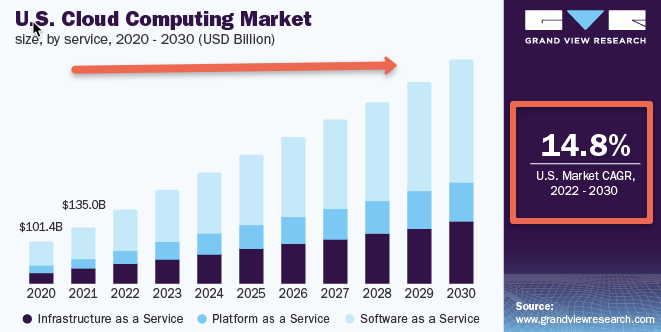The outlook for the cloud services sector shows a promising trend over the coming years. According to one of the leading research institutes, Gartner, the cloud security sector is expected to touch nearly the $5.9 billion dollar mark indicating strong growth in the market for cloud-based services. Reports from one of the other leading analyst firms, Forrester Research group suggests the same trend indicating higher spending in the cloud security market.
Cloud Computing Trends
Against the backdrop of the optimal setting for the cloud services industry, it is important to know some of the major trends that have occurred in this sector. This article focuses on three such important trends that have been changing the cloud solutions market substantially.
grandviewresearch.com

1. Increased Number of SMEs Coming Into the Cloud Computing Sector
There has been a noticeable increase in the number of SMBs (Small and Medium Businesses) adopting cloud technologies. The trend is not only on account of the ease and scalability that cloud platforms provide to drive top-line growth but also attributable to highly cost-effective solutions that could be performed without setting up in-house technologies.
For example, Microsoft Office 365 has replaced the Exchange Email platform just on account of eliminating the need for hardware and server licensing requirements.
Although the new Office 365 is a replica of the traditional Exchange Email, it has extended the capabilities largely by introducing a huge amount of space and backup abilities along with room for extensive analytics. This is a big shift in the IT sphere with SMBs gearing towards such cost-effective solutions with hardly any investment.
2. Shift in Focus from Physical Hardware to Services by Technology Distributors
The days of technology distributors providing hardware and software solutions have slowly started fading away with more active participation in the game of providing services to customers out of their personally owned and built data storage centers. There is a growing trend of aggregation of cloud service distributors that you can witness. This makes the cloud services sector look more prospective with better management and easier integration.
There is a growing trend of aggregation of the cloud service distributors that you can witness. This makes the cloud services sector look more prospective with better management and easier integration.
3. A Centralized Storage Distribution Model
Although this has been on the market for quite a while now, cloud-based technological services are gearing more and more towards a centralized storage and distribution mechanism in order to cater to the needs of the IT industry and SMBs in a more effective way. The new architecture is expected to streamline the cloud services sector and make it more organized with a framework that sits on the apex and manages the individual cloud technology demands.
Conclusion
The gamut of changes in the cloud space is highly expected to bring about a series of improvements and untracked opportunities for service providers and SMB customers alike.
As the individual service firms are turning into aggregate providers, they are likely to be able to grow the businesses by effective packaging and embracing all the ISV (Independent Software Vendor) services under one roof.
SMBs are also going to benefit largely from this technological trend wherein they are slowly going to replace the need for costly in-house technological infrastructure with cost-effective cloud-based solutions.

